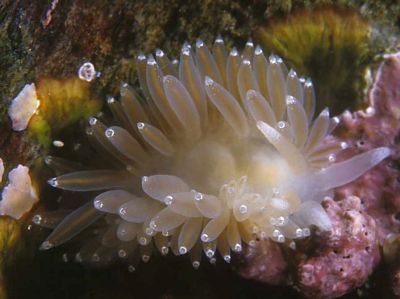
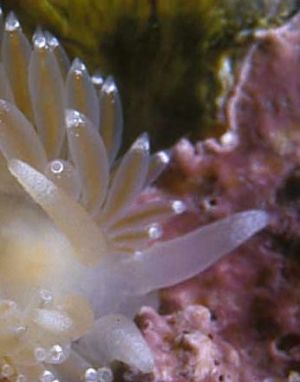
Flabellina salmonacea
(Cuthouy, 1838)
Order: NUDIBRANCHIA
Suborder: AEOLIDINA
Family: Flabellinidae
DISTRIBUTION
Western Atlantic - Gulf of Maine north to Halifax, Nova Scotia, Greenland. Eastern Atlantic - from Iceland, Spitzbergen, nth coast of Norway, Arctic seas. North Pacific - from British Columbia, Canada.
PHOTO
New England, USA [Atlantic coast]. Photo: Paul Young.
Body translucent white, ceratal digestive gland orange to deep brown, subapical white band on cerata, oral tentacles and rhinophores with a white patch at the tip. Body broad, width exceeding height.
Found feeding and laying eggs on the colonial tunicate Amaroucium constellatum Verrill, 1871 from December to March. Small juveniles reported to feed on a variety of hydroids in late summer and early autumn, principally Tubularia. Adults also feed on Tubularia spectabilis. Grows to between 20-40 mm long.
Reference:
• Kuzirian, A.M. (1979) Taxonomy and biology of four New England coryphellid nudibranchs. Journal of Molluscan Studies, 45: 239-261.
Rudman, W.B., 2001 (June 18) Flabellina salmonacea (Cuthouy, 1838). [In] Sea Slug Forum. Australian Museum, Sydney. Available from http://www.seaslugforum.net/find/flabsalm
Related messages
Flabellina salmonacea from Massachusetts, USA
August 3, 2007
From: Paul Young
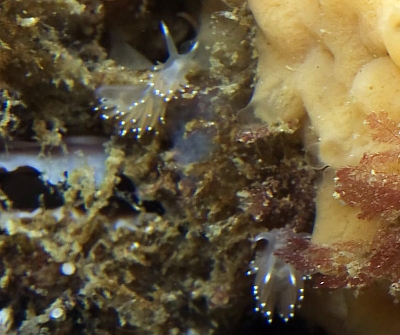
Dear Bill
While diving on Halfway Rock, between Gloucester and Boston we saw the smallest 'Salmon-Gills' [Flabellina salmonacea ] I have ever seen and a Cadlina which looks like the ones I have already sent you.
Locality: Halfway Rock, near Gloucester, 30 feet, Massachusetts, USA, Atlantic, 22 July 2007. Length: 1/2 inch. Photographer: Paul Young.
Paul Young
youngp@hp.com
Young, P, 2007 (Aug 3) Flabellina salmonacea from Massachusetts, USA. [Message in] Sea Slug Forum. Australian Museum, Sydney. Available from http://www.seaslugforum.net/find/20310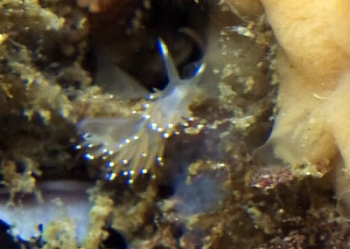
Dear Paul,
They are too small for me to identify from photos so I will take your word, as the 'local expert' on this species, for the identification
Best wishes,
Bill Rudman
Color variation in Flabellina salmonacea
March 31, 2006
From: Alan Shepard
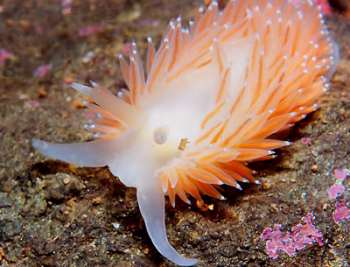
Dear Bill -
Here is a photo of a color variation of Flabellina salmonacea. The shot was taken in August 2004 off Deer Island, New Brunswick, Canada.
According to Dr. Larry Harris the orange coloration is due to a diet consisting of burrowing and Goniactinia anemones rather than ascidians.
Dr. Harris pointed out that at one point this variation was considered Coryphella stimpsoni but was later combined with C. salmonacea (now F. salmonacea ) by Terry Gosliner and Alan Kuzirian as one species.
This is the only orange variation I've encontered in many dives in the Passamaquoddy Bay but I'm told at times there are huge numbers that coincide with explosions of the anemone prey.
Locality: Deer Island, 8 metres, New Brunswick, Canada, Passamaquoddy Bay, August 2004, cobble bottom, strong tidal flow. Length: 40mm. Photographer: Alan Shepard.
Best wishes,
Alan Shepard
alan.chepard@snet.net
Shepard, A., 2006 (Mar 31) Color variation in Flabellina salmonacea. [Message in] Sea Slug Forum. Australian Museum, Sydney. Available from http://www.seaslugforum.net/find/16194Thanks Alan,
Bill Rudman
Flabellina salmonacea with swollen oral tentacles.
March 6, 2003
From: Alan Shepard
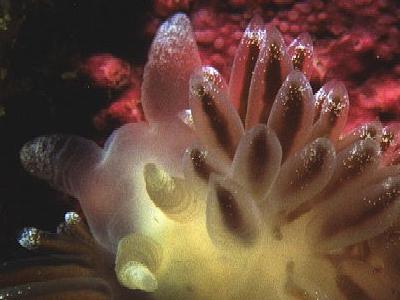
Bill -
Though you might find this photo of Flabellina salmonacea a bit interesting. The oral tentacles look to be swollen quite a bit. I assume this occured during a feeding session. Do nudibranchs ever get used to being stung?
The photo was taken at Folly Cove in Gloucester, Massachusetts, USA in approximately 7 meteres of water. The nudibranch was approximately 50mm long.
Alan Shepard
Tolland, CT, USA
alan.chepard@snet.net
Shepard, A., 2003 (Mar 6) Flabellina salmonacea with swollen oral tentacles.. [Message in] Sea Slug Forum. Australian Museum, Sydney. Available from http://www.seaslugforum.net/find/9315Thanks Alan,
An interesting question. I don't know if this has been studied in any detail but from my experience, aeolids always seem to treat their food items with some care when feeding - and certainly retract quickly when apparently stung. Concerning 'swelling'. A swollen tentacle like this is rather different from us having a swollen appendage after a sting. In our case it is the cells of the skin and the underlying tissue which swell as an allergic reaction. In the case of a slug the skin is in many ways just a blood-filled bag which contains the body organs. As they have no rigid skeleton the nudibranch's shape can change much like a water-filled balloon. What seems to have happened here is the head has retracted - perhaps after being stung - and forced the blood from the body cavity up into the cerata and the tentacles causing them to inflate. They are definitely swollen but in quite a different way from how we would swell after being stung.
Best wishes,
Bill Rudman
Flabellina salmonacea from Massachusetts, USA
May 16, 2002
From: Alan Shepard
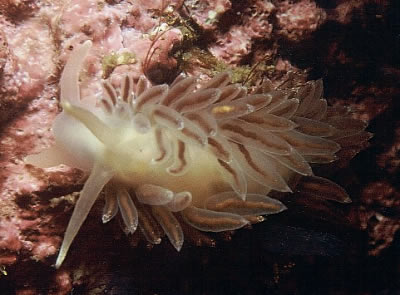
Dear Dr. Rudmann -
Here's another recent photo I took while diving in Gloucester, Massachusetts. It is Flabellina salmonacea according to Dr. Larry Harris at the University of New Hampshire. It was in about 7m of water and measured about 33mm long.
Sincerely,
Alan Shepard
alan.chepard@snet.net
Shepard,A., 2002 (May 16) Flabellina salmonacea from Massachusetts, USA. [Message in] Sea Slug Forum. Australian Museum, Sydney. Available from http://www.seaslugforum.net/find/6918Thanks Alan,
Your animal looks almost identical to those in Paul Young's photos from New England. It's nice to have some consistent colour patterns now and then.
Best wishes,
Bill Rudman
Flabellina salmonacea from British Columbia
March 25, 2002
From: Marli Wakeling
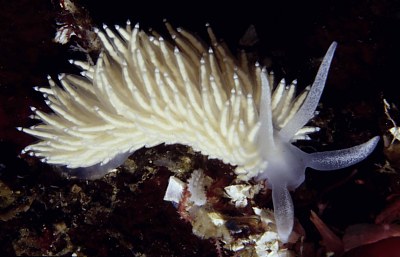
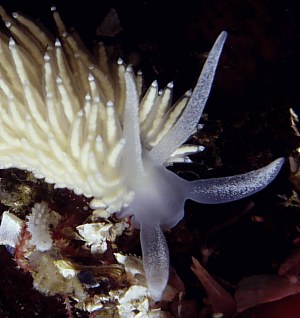
Hi Bill,
Here is Flabellina salmonacea, commonly known here as a "shaggy mouse nudibranch". This one was found on Crimson Wall, at the north end of the Sechelt Peninsula.
PHOTO: Crimson Wall, Agamemnon Channel, Sechelt peninsula, British Columbia, Canada
DEPTH: 50 feet
LENGTH: 15mm
DATE: January 6, 2001
PHOTO BY: Marli Wakeling
scubamarli@excite.com
Wakeling, M., 2002 (Mar 25) Flabellina salmonacea from British Columbia. [Message in] Sea Slug Forum. Australian Museum, Sydney. Available from http://www.seaslugforum.net/find/6488Thanks Marli,
I find these species which apparently live in the North Atlantic and the North Pacific very interesting. They have either been there an awfully long time or their larvae have made a cold journey under the Arctic ice cap. I wonder if anyone can give us a summary of the current hypothesis concerning these distributions?
Best wishes,
Bill Rudman
Flabellina salmonacea from New England
June 20, 2001
From: Paul Young


There are several species of Flabellina species found in New England, USA [Atlantic coast]. We think there are at least three or four, and they are probably our most common nudibranches.
The ones which are red or chocolate brown are locally called red-gills [see separate message] and the pale orange ones are usually called salmon-gills. We think they are Flabellina salmonacea.
Both red-gills and salmon-gills get to be 3-4 cm long.
Paul Young
young@underwater.org
Young, P., 2001 (Jun 20) Flabellina salmonacea from New England. [Message in] Sea Slug Forum. Australian Museum, Sydney. Available from http://www.seaslugforum.net/find/4634Thanks Paul,
I have checked you identification with Terry Gosliner and he confirms it is F. salmonacea. I have included an enlargement of part of the photo to show the characteristic white tipped rhinophores and oral tentacles, and the white ring just below the tip of each ceras.
Best wishes,
Bill Rudman
